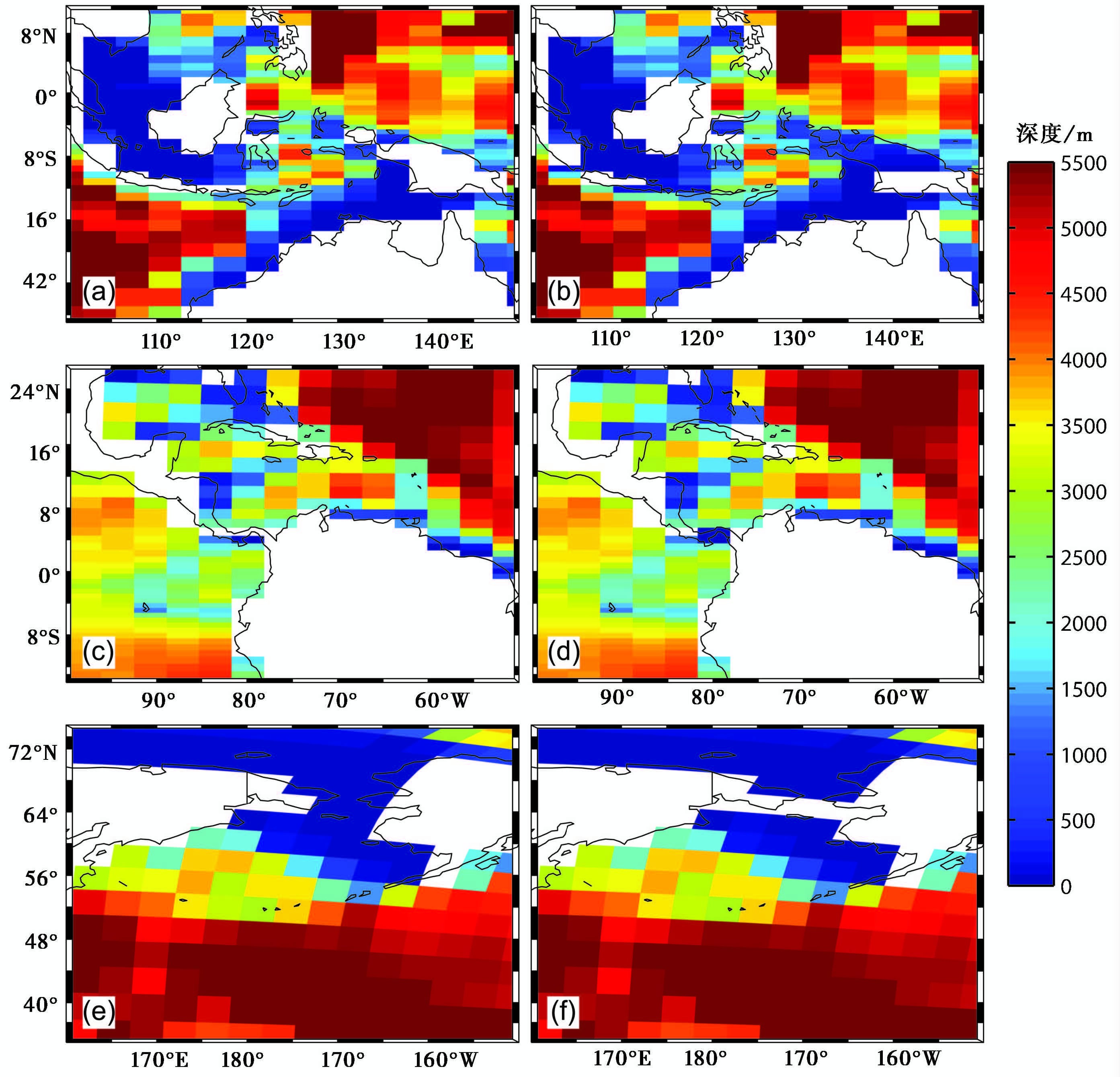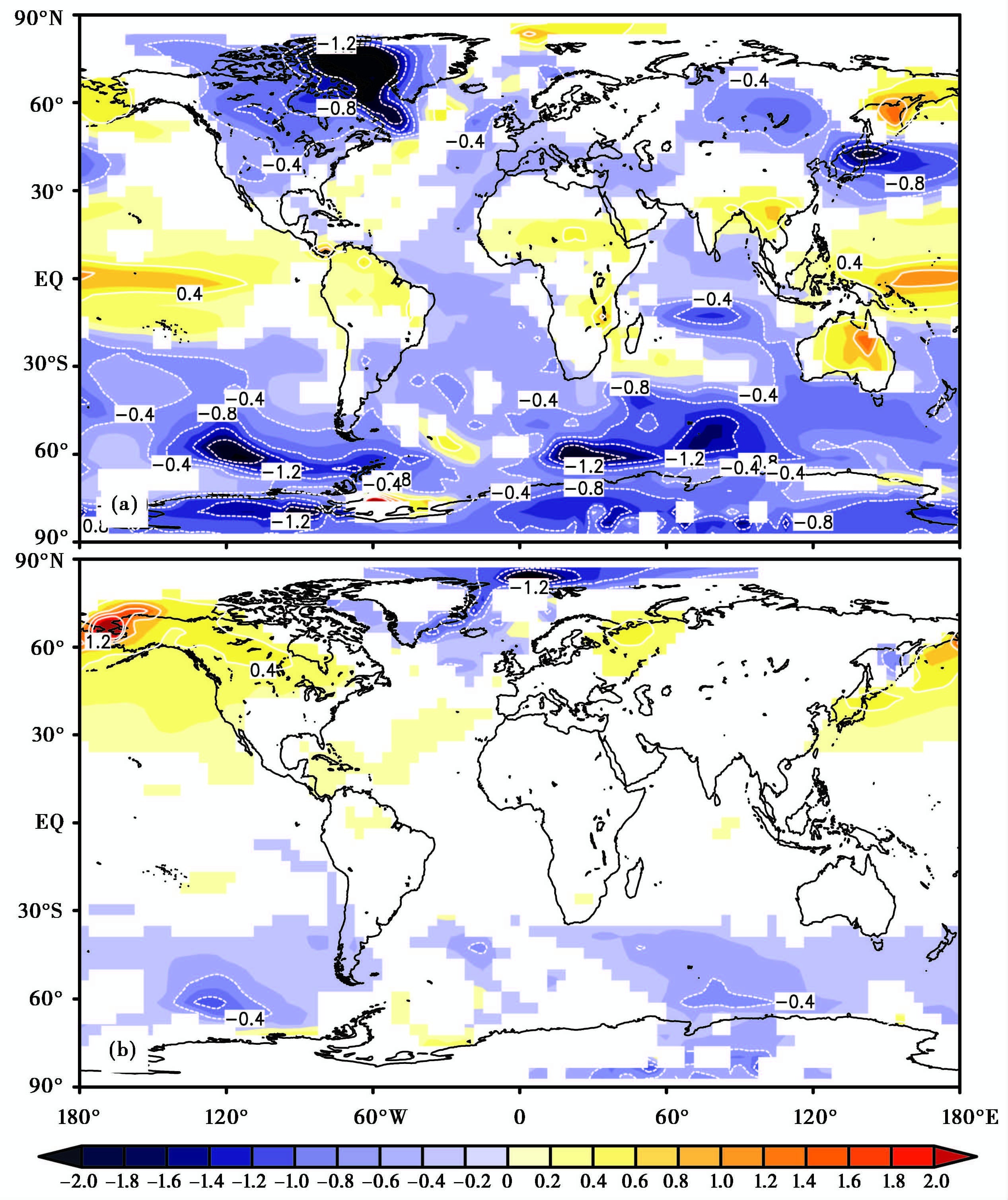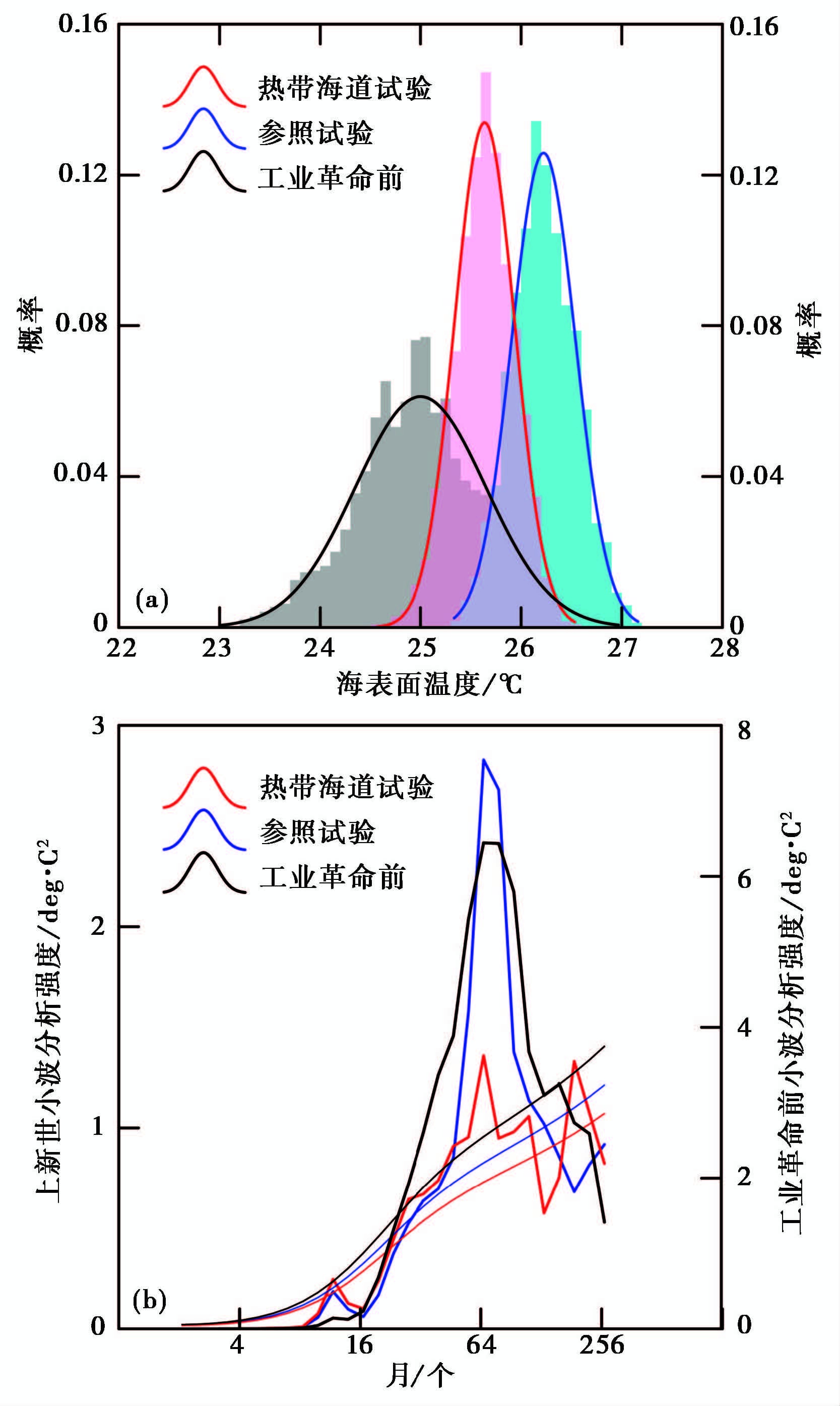②. 中国科学院大气物理研究所 竺可桢-南森国际研究中心, 北京 100029;
③. Uni Research Climate, Bjerknes Centre for Climate Research, Allégaten 70, Bergen 5007, Norway;
④. 中国科学院气候变化研究中心, 北京 100029)
上新世3~4Ma是晚新生代全球气候发生转折、 开始变冷的关键时期。这一转折的重要证据来自于全球海表面温度的重建[1~6]。最近的全球海表面温度综合显示,上新世以来,全球高纬地区、 上升流区海表面温度逐渐降低[1, 2]; 尤其是上升流区,海表面温度从约4Ma开始降温更为明显[2]。在热带,东、 西热带太平洋之间的温度梯度,虽然在上新世之前就已经形成[7],但从约4Ma开始进一步增加[3]。在我国,黄土高原黄土-古土壤序列的粒度或磁化率等记录,揭示3~4Ma是粒度变粗、 磁化率波动幅度增加的关键时期[8~12],但约4Ma前后这些指标的变化并没有3Ma那么显著。当然,宁夏固原寺口子组沉积物中的粒度、 红度等指标[13],以及陕西白水沉积物中化学蚀变指数和烧失量[14],都从约4Ma出现明显的变化。在我国南海,1148孔的氧同位素记录以及1146孔的陆源沉积比例从约4Ma开始增加[15, 16]。
这一时期,气候转折往往和海道变化触发的全球变冷联系在一起; 其中,受到关注的是中美海道(也称为巴拿马海道)和印尼海道[17~21]。 Molnar[22]曾经总结了指示中美海道变化的关键证据,虽然最可靠的证据是南、 北美洲之间大规模的动物群交流,指示中美海道在第四纪早期完全关闭; 但加勒比海和太平洋海洋表层的氧同位素梯度在4.7~4.2Ma之间开始加强[23],至少说明中美海道在这一时期变窄变浅限制了加勒比海和太平洋之间表层的海水交换。中美海道的变窄或关闭,可以加强北大西洋的经向翻转环流,曾被认为是导致北半球冰期开始的关键触发机制[17, 18, 24]。Cane和Molnar[19]曾经推断,3~4Ma之间印尼海道变窄,限制了印尼穿越流,使得印度洋降温,从而加剧了东非的干旱化。
大约4Ma以前,除了热带海道(即中美海道和印尼海道)外,另一个显著的海道变化,即白令海峡打开,发生在北半球高纬地区。北美阿拉斯加南部发现的双壳软体动物Astarte,揭示大约5Ma白令海峡已经打开[25],但只有少量太平洋软体动物,经过北冰洋进入北欧海[26]; 直到大约4.5Ma,太平洋的软体动物大规模的出现在北欧海[26],说明白令海峡已经达到足以影响海洋环流的深度。然而,白令海峡打开,在过去的模拟研究中往往是被忽视的,直到最近的研究揭示白令海峡的变化可以影响北大西洋的经向翻转环流[27]。可见,白令海峡打开和热带海道关闭均对上新世气候具有重要影响,但至今仍缺少对两者在高纬、 低纬乃至我国气候影响的对比研究。
这里,我们用挪威地球系统模式(NorESM),来模拟白令海峡打开对中国上新世气候的可能影响,并与热带海道(中美海道和印尼海道)作用进行比较。接下来的第二部分先介绍模式和试验设计,然后第三部分是模拟结果,最后是讨论和总结。
2 模式介绍和试验设计 2.1 模式介绍挪威地球系统模式(NorESM),是在美国通用地球系统模式(CESM,有关模式资料请参考网址http://www2.cesm.ucar.edu/)基础上开发的地球系统模式。这两个模式最大的区别在于,挪威地球系统模式对大气化学、 气溶胶和云的处理进行了修改,并且把海洋模块改成了迈阿密等密度面海洋模式(MICOM)[28]。挪威地球系统模式的低分辨率版本(NorESM-L)专门发展用于古气候模拟。它的大气模块,采用通用大气模式(CAM4)的谱模式版本[29, 30],其水平分辨率是T31(大约3.75度),垂直方向26层。 它的海洋模块,采用非规则格点,北极置于格陵兰,南极置于南极洲; 水平分辨率g37(大约3度),垂直方向上分为32层。这个模式合理的模拟了工业革命前的气候状况,模拟结果与观测一致[31, 32]。详细的模式介绍,可以在Zhang等[31, 32]和Bentsen等[28]发表的模式介绍与评估的文章上找到。这一模式在古气候模拟中的应用取得了非常重要的进展。它合理的模拟出,上新世北半球高纬地区的增温和南大洋海水混合的加强[32, 33]; 更进一步揭示了特提斯海收缩对亚热带撒哈拉沙漠的起源的作用[34]。
2.2 试验设计为了回答上述的科学问题,我们在上新世模拟对比计划第一阶段(PlioMIP I)约3Ma试验设计的基础上[31, 32],设计了另外的3个试验,分别是参照试验(REF)、 热带海道试验(TRP)和白令海峡试验(BER)(表 1)。参照试验,与PlioMIP I的约3Ma上新世标准试验几乎一致; 唯一的差别是这个试验中巴伦支海变成了陆地,因为已有的地质证据表明,巴伦支海在上新世的时候并没有形成[35]。这样的参照试验更加接近上新世的海陆分布状况。在参照试验的基础上,热带海道试验中的中美海道被打开,深度25m(图 1); 印尼海道被加宽(图 1)。在热带海道试验的基础上,白令海道试验中白令海峡被关闭(图 1)。这样,参照试验与热带海道试验的差别(REF-TRP)就可以揭示热带海道关闭/收缩的气候效应; 热带海道试验与白令海峡试验的差别(TRP-BER),就可以揭示白令海峡打开的气候效应。这3个海气耦合试验,每个积分2200年。这里,我们分析最后200年的平均气候态。
| 表 1 试验设计 Table 1 Experiment design |

|
图 1 试验中印尼海道(a, b)、 中美海道(c, d)和白令海峡(e, f)开启/关闭的变化。填色代表深度(m) Fig. 1 Configurations of Indonesian Seaway(a, b), Central American Seaway(c, d) and Bering Strait(e, f) used in the experiments. Shaded regions show depths(m) |
3 模拟结果
模拟的全球地表气温的变化结果表明,热带海道和白令海峡的变化都可以引起全球大部分地区的气候响应(图 2)。然而,白令海峡打开的气候影响主要集中在中、 高纬地区,它对热带气候的影响并不显著(图 2b)。

|
图 2 热带海道关闭/收缩(a)和白令海峡打开(b)对全球地表温度(单位℃)的影响 Fig. 2 Changes in surface air temperature(unit:℃)due to the closure of tropical seaways (a) and the opening of Bering Strait(b) |
对于中国区域气候而言,热带海道的作用比白令海峡的作用更加重要(图 3)。热带海道关闭/收缩,可以引起我国东北和西南地区的气候响应(图 3a和3c)。结果表明,我国东北地区,年平均温度降低0.2~0.6℃,年降水量减少100mm以下; 我国西南地区,年平均温度升高0.2~0.6℃,局部地区年降水量减少超过100mm。与热带海道关闭/收缩的作用相比,白令海峡打开引起我国年平均温度和降水的变化并不显著,几乎可以忽略(图 3b和3d)。

|
图 3 热带海道关闭/收缩(上, a, c)和白令海峡打开(下, b, d)对中国地表温度(左,单位℃)和年降水量(右,单位mm)的影响 Fig. 3 Changes in annual surface air temperature(left panel, unit:℃)and precipitation(right panel, unit: mm)in China, caused by the closure of tropical seaways(a, c)and the opening of Bering Strait(b, d) |
很显然,热带海道关闭/收缩使得热带太平洋海表面温度升高,印度洋海表面温度降低(图 2a); 并且,由于西热带太平洋的增温幅度更大,热带太平洋东、 西之间的温度梯度明显加大(图 2a)。伴随着温度梯度的变化,热带太平洋厄尔尼诺-南方涛动(ENSO)年代际变率加强。在海表面温度的直方图中,参照试验模拟的海表面温度分布的宽度明显大于热带海道试验,很好的说明了这一点(图 4)。当然,参照试验模拟的ENSO变率,与工业革命前试验的模拟结果相比,要弱很多; 这与我们已经发表的PlioMIP上新世试验标准是相一致的[36]。更为重要的是,热带海道关闭/收缩明显改变了ENSO振荡的周期。参照试验模拟的ENSO周期与工业革命前试验的模拟结果更为相似。

|
图 4 Nino 3.4区11月平滑海表面温度直方图(a)和小波周期分析(b) Fig. 4 Histograms for 11-month smoothed Nino 3.4 sea surface temperature, black for the pre-industrial experiment, blue for the reference experiment, and red for the tropical experiment. (b)ENSO periods calculated with wavelet analyses based on 11-month smoothed Nino 3.4 sea surface temperatures |
4 讨论和总结
上述的这些结果揭示出,与白令海峡的作用相比,热带海道的变化对我国上新世气候演化起了更加重要的作用; 就海道变化对上新世地表气候的影响来看,白令海峡的作用主要局限于高纬地区,而热带海道的变化则会引起全球范围的气候变化。虽然,白令海峡的变化对中国上新世气候影响并不显著,甚至非洲、 南美等中低纬大部分地区也不显著,但这并不说明白令海峡对全球气候影响不重要。白令海峡的变化可以影响海洋中层或深层水的环流,从而将南北两半球高纬地区地表气候变化联系起来。相对来说,热带海道的变化对全球地表气候的影响更加直接、 更加明显。
这些模拟结果揭示,热带海道的变化可以引起全球大范围地区的温度降低、 热带太平洋(尤其热带西太平洋)表面温度升高; 但我们目前的研究并没有揭示这些温度变化后面的动力学机制,也没有揭示这些温度变化是如何对我国气候产生影响的。这需要进一步开展高分辨率的大气模式模拟,是我们下一步需要开展的工作。从现代气候的研究结果来看[37, 38],热带太平洋表面温度变化非常有可能是影响我国上新世气候演化的关键因素之一。
在热带海道关闭/收缩之前,较弱的热带太平洋东西之间的温度梯度,与地质记录的重建是相一致的,被称为“类永久El Niño”[3, 39, 40]。需要说明的是,类永久El Niño是一个容易被混淆的概念。El Nino是热带太平洋海表面温度年代际变化ENSO中的正异常,与之对应的是La Niña[41, 42]。类永久El Niño的概念,并不是指热带太平洋海表面温度年代际变化完全消失,在菲律宾发现的上新世珊瑚氧同位素记录显示上新世ENSO年代际振荡仍然存在[38]; 也不一定指热带太平洋东西之间的温度梯度完全消失[7]。其实,类永久El Niño可以是以下的这种情况,热带太平洋东西之间的温度梯度相对比较弱[3],并且其海温年代际变化幅度相对比较小[43, 44],就如同热带海道试验模拟的情形。
随后,热带海道关闭/收缩、 以及上新世以来的全球变冷,使得类永久El Niño的条件消失。热带海道关闭/收缩加强了热带太平洋东西之间的梯度; 上新世以来的全球变冷,逐步放大ENSO年代际变率。温度梯度的变化是和ENSO变率的变化联系在一起,虽然这背后的机制还需要进一步的研究。但对于上新世中国平均气候态的演化来说,海表面温度的平均态的改变起到了更加直接的作用。
综上所述,对于上新世中国的气候演化来说,白令海峡打开的直接作用并不重要; 与之相比,热带海道关闭/收缩引起热带太平洋海表面温度平均态的改变,对中国上新世气候演化起到更加重要的作用。但,热带海道(中美海道和印尼海道)和高纬海道(白令海峡)的变化是如何引起上新世以来全球逐步变冷、 区域气候发生改变,仍是今后值得需要进一步回答的重要科学问题; 这些变化与古植物、 古动物乃至古人类的演化联系在一起。
| 1 |
Brierley Chris M, Fedorov Alexey V, Liu Zhonghui, et al. Greatly expanded tropical warm pool and weakened hadley circulation in the Early Pliocene[J].
Science,2009, 323 (5922) : 1714~1718.
( 0) 0)
|
| 2 |
Fedorov A V, Brierley C M, Lawrence K T, et al. Patterns and mechanisms of Early Pliocene warmth[J].
Nature,2013, 496 (7443) : 43~49.
( 0) 0)
|
| 3 |
Wara Michael W, Ravelo Ana Christina, Delaney Margaret L. Permhanent El Niño -like conditions during the Pliocene warm period[J].
Science,2005, 309 (5735) : 758~761.
( 0) 0)
|
| 4 |
Herbert Timothy D, Peterson Laura Cleaveland, Lawrence Kira T, et al. Tropical Ocean temperatures over the past 3[J].
Science,2010, 328 (5985) : 1530~1534.
( 0) 0)
|
| 5 |
Sosdian Sindia, Rosenthal Yair. Deep-sea temperature and ice volume changes across the Pliocene-Pleistocene climate transitions[J].
Science,2009, 325 (5938) : 306~310.
( 0) 0)
|
| 6 |
O'Brien Charlotte L, Foster Gavin L, Martinez-Boti Miguel A, et al. High sea surface temperatures in tropical warm pools during the Pliocene[J].
Nature Geoscience,2014, 7 (8) : 606~611.
( 0) 0)
|
| 7 |
Zhang Yige, Pagani Mark, Liu Zhonghui. A 12-Million-year temperature history of the tropical Pacific Ocean[J].
Science,2014, 344 (6179) : 84~87.
( 0) 0)
|
| 8 |
Ding Z L, Xiong S F, Sun Jac M, et al. Pedostratigraphy and paleomagnetism of a -7[J].
Palaeogeography, Palaeoclimatology, Palaeoecology,1999, 152 (1-2) : 49~66.
( 0) 0)
|
| 9 |
Guo Z T, Peng S Z, Hao Q Z, et al. Origin of the Miocene-Pliocene Red-Earth formation at Xifeng in Northern China and implications for paleoenvironments[J].
Palaeogeography, Palaeoclimatology, Palaeoecology,2001, 170 (1-2) : 11~26.
( 0) 0)
|
| 10 |
Ding Z L, Derbyshire E, Yang S L, et al. Stepwise expansion of desert environment across Northern China in the past 3.5Ma and implications for monsoon evolution[J].
Earth and Planetary Science Letters,2005, 237 (1-2) : 45~55.
( 0) 0)
|
| 11 |
Sun Youbin, Lu Huayu, An Zhisheng. Grain size of loess, palaeosol and Red Clay deposits on the Chinese Loess Plateau:Significance for understanding pedogenic alteration and palaeomonsoon evolution[J].
Palaeogeography, Palaeoclimatology, Palaeoecology,2006, 241 (1) : 129~138.
( 0) 0)
|
| 12 |
Jiang Hanchao, Ding Zhongli. Eolian grain-size signature of the Sikouzi lacustrine sediments(Chinese Loess Plateau):Implications for Neogene evolution of the East Asian winter monsoon[J].
Geological Society of America Bulletin,2010, 122 (5-6) : 843~854.
( 0) 0)
|
| 13 |
Jiang Hanchao, Mao Xue, Xu Hongyan, et al. -4Ma coarsening of sediments from Baikal, Chinese Loess Plateau and South China Sea and implications for the onset of NH glaciation[J].
Palaeogeography, Palaeoclimatology, Palaeoecology,2010, 298 (3-4) : 201~209.
( 0) 0)
|
| 14 |
Xiong Shangfa, Ding Zhongli, Zhu Yuanjian, et al. A -6Ma chemical weathering history, the grain size dependence of chemical weathering intensity, and its implications for provenance change of the Chinese loess-red clay deposit[J].
Quaternary Science Reviews,2010, 29 (15-16) : 1911~1922.
( 0) 0)
|
| 15 |
Wan Shiming, Li Anchun, Clift Peter D, et al. Development of the East Asian monsoon:Mineralogical and sedimentologic records in the northern South China Sea since 20Ma[J].
Palaeogeography, Palaeoclimatology, Palaeoecology,2007, 254 (3-4) : 561~582.
( 0) 0)
|
| 16 |
Tian Jun, Zhao Quanhong, Wang Pinxian, et al. Astronomically modulated Neogene sediment records from the South China Sea[J].
Paleoceanography,2008, 23 (3) : PA3210.
( 0) 0)
|
| 17 |
Keigwin Lloyd. Isotopic paleoceanography of the Caribbean and East Pacific:Role of Panama uplift in Late Neogene time[J].
Science,1982, 217 (4557) : 350~353.
( 0) 0)
|
| 18 |
Haug Gerald H, Tiedemann Ralf. Effect of the formation of the Isthmus of Panama on Atlantic Ocean thermohaline circulation[J].
Nature,1998, 393 (6686) : 673~676.
( 0) 0)
|
| 19 |
Cane Mark A, Molnar Peter. Closing of the Indonesian seaway as a precursor to East African aridification around 3-4 million years ago[J].
Nature,2001, 411 (6834) : 157~162.
( 0) 0)
|
| 20 |
Jochum M, Fox-Kemper B, Molnar P H, et al. Differences in the Indonesian seaway in a coupled climate model and their relevance to Pliocene climate and El Niño[J].
Paleoceanography,2009, 24 (1) : PA1212.
( 0) 0)
|
| 21 |
Karas Cyrus, Nurnberg Dirk, Gupta Anil K, et al. Mid-Pliocene climate change amplified by a switch in Indonesian subsurface throughflow[J].
Nature Geoscience,2009, 2 (6) : 434~438.
( 0) 0)
|
| 22 |
Molnar Peter. Closing of the Central American Seaway and the Ice Age:A critical review[J].
Paleoceanography,2008, 23 (2) : PA2201.
( 0) 0)
|
| 23 |
Haug Gerald H, Tiedemann Ralf, Zahn Rainer, et al. Role of Panama uplift on oceanic freshwater balance[J].
Geology,2001, 29 (3) : 207~210.
( 0) 0)
|
| 24 |
Maier-Reimer Ernst, Mikolajewicz Uwe, Crowley Thomas. Ocean General Circulation Model Sensitivity Experiment with an open Central American Isthmus[J].
Paleoceanography,1990, 5 (3) : 349~366.
( 0) 0)
|
| 25 |
Marincovich Louie, Gladenkov Andrey Yu. Evidence for an early opening of the Bering Strait[J].
Nature,1999, 397 (6715) : 149~151.
( 0) 0)
|
| 26 |
Verhoeven Koen, Louwye Stephen, Eiríksson Jón, et al. A new age model for the Pliocene-Pleistocene Tjörnes section on Iceland:Its implication for the timing of North Atlantic-Pacific palaeoceanographic pathways[J].
Palaeogeography, Palaeoclimatology, Palaeoecology,2011, 309 (1-2) : 33~52.
( 0) 0)
|
| 27 |
Hu Aixue, Meehl Gerald A, Han Weiqing, et al. Effects of the Bering Strait closure on AMOC and global climate under different background climates[J].
Progress in Oceanography,2015, 132 : 174~196.
( 0) 0)
|
| 28 |
Bentsen M, Bethke I, Debernard J B, et al. The Norwegian Earth System Model, NorESM1-M-Part 1:Description and basic evaluation of the physical climate[J].
Geoscientific Model Development,2013, 6 (3) : 687~720.
( 0) 0)
|
| 29 |
Eaton Brian. User’s Guide to the Community Atmosphere Model CAM-4.0. http://www.cesm.ucar.edu/models/ccsm4.0/camdocsusers_guide/ug.html, 2010
( 0) 0)
|
| 30 |
Neale Richard B, Richter Jadwiga H, Conley Andrew J et al. Description of the NCAR community atmosphere model(CAM 4.0). In: NCAR Technical Note NCAR/TN-486+STR, 2010
( 0) 0)
|
| 31 |
Zhang Z, Yan Q. Pre-industrial and Mid-Pliocene simulations with NorESM-L:AGCM simulations[J].
Geoscientific Model Development,2012, 5 (4) : 1033~1043.
( 0) 0)
|
| 32 |
Zhang Z S, Nisancioglu K, Bentsen M, et al. Pre-industrial and Mid-Pliocene simulations with NorESM-L[J].
Geoscientific Model Development,2012, 5 (2) : 523~533.
( 0) 0)
|
| 33 |
Zhang Zhongshi, Nisancioglu Kerim H, Ninnemann Ulysses S. Increased ventilation of Antarctic deep water during the warm Mid-Pliocene[J].
Nature Communications,2013, 4 : 1499.
( 0) 0)
|
| 34 |
Zhang Zhongshi, Ramstein Gilles, Schuster Mathieu, et al. Aridification of the Sahara Desert caused by Tethys Sea shrinkage during the Late Miocene[J].
Nature,2014, 513 (7518) : 401~404.
( 0) 0)
|
| 35 |
Butt Faisal A, Drange Helge, Elverhñi Anders, et al. Modelling Late Cenozoic isostatic elevation changes in the Barents Sea and their implications for oceanic and climatic regimes:Preliminary results[J].
Quaternary Science Reviews,2002, 21 (14-15) : 1643~1660.
( 0) 0)
|
| 36 |
Zhang Zhongshi, Yan Qing, Su Jingzhi, et al. Has the problem of a permanent El Niño been resolved for the Mid-Pliocene?[J].
Atmospheric and Oceanic Science Letters,2012, 5 (6) : 445~448.
( 0) 0)
|
| 37 |
Wang Bin, Wu Renguang, Fu Xiouhua. Pacific-East Asian teleconnection:How does ENSO affect East Asian climate?[J].
Journal of Climate,2000, 13 (9) : 1517~1536.
( 0) 0)
|
| 38 |
Watanabe Tsuyoshi, Suzuki Atsushi, Minobe Shoshiro, et al. Permanent El Niño during the Pliocene warm period not supported by coral evidence[J].
Nature,2011, 471 (7337) : 209~211.
( 0) 0)
|
| 39 |
Molnar Peter, Cane Mark A. El Niño 's tropical climate and teleconnections as a blueprint for pre-Ice Age climates[J].
Paleoceanography,2002, 17 (2) .
doi: 10.1029/2001PA000663 ( 0) 0)
|
| 40 |
Christina Ravelo Ana, Simonne Dekens Petra, McCarthy Matthew. Evidence for El Niño -like conditions during the Pliocene[J].
GSA Today,2006, 16 (3) .
( 0) 0)
|
| 41 |
Allan Rob, Lindesay Janette, Parker David. El Niño :Southern Oscillation and Climatic Variability. Collingwood, Victoria:CSIRO. 1996. 416
( 0) 0)
|
| 42 |
Trenberth Kevin E. The definition of El Niño[J].
Bulletin of the American Meteorological Society,1997, 78 (12) : 2771~2777.
( 0) 0)
|
| 43 |
Fedorov Alexey V, Philander S George. Is El Niño changing?[J].
Science,2000, 288 (5473) : 1997~2002.
( 0) 0)
|
| 44 |
Brierley Chris M. Interannual climate variability seen in the Pliocene Model Intercomparison Project[J].
Climate of the Past,2015, 11 : 605~618.
( 0) 0)
|
②. Nansen-Zhu International Research Centre, Institute of Atmospheric Physics, Chinese Academy of Sciences, Beijing 100029;
③. Uni Research Climate, Bjerknes Centre for Climate Research, Allégaten 70, Bergen 5007, Norway;
④. Climate Change Research Center, Chinese Academy of Sciences, Beijing 100029)
Abstract
Remarkable global cooling happened since the Pliocene about 3~4Ma ago. This cooling was often linked to changes in seaways during this period. Previous modelling studies focused mainly on the changes in tropical seaways, including the closing of Central America Seaway and the narrowing of Indonesian Seaway, but paid less attentions to changes in high latitude seaways, for example the opening of the Bering Strait. With the Norwegian Earth System model, this study simulates the climate effects due to the changes in the tropical seaways and the Bering Strait. These simulations demonstrate that the changes in the tropical seaways and the Bering Strait cause surface climate responses in most global regions. The opening of the Bering Strait causes the climate responses mainly in mid- and high-latitudes. The closing/narrowing of the tropical seaways leads to cooling in most regions, but warming in the tropical Pacific. Regionally, the closing/narrowing of the tropical seaways plays a more important role in Chinese climate evolution during the Pliocene, in relative to the opening of the Bering Strait. The closing/narrowing of the tropical seaways causes climate responses in Northeast and Southwest China. In Northeast China, the annual temperature decreases about 0.2~0.6℃, and the annual precipitation decreases by 100mm. In Southwest China, the annual temperature increases about 0.2~0.6℃, and the annual precipitation decreases more than 100mm. In contrast, the climate responses due to the opening of the Bering Strait are insignificant in China. The importance of tropical seaways on the regional climate in China is linked to the modification of tropical ocean temperature. The closing/narrowing of the tropical seaways, which intensifies the temperature gradient between the east and the west tropical Pacific and enhances ENSO variability, leads to the stronger regional climate responses in China, in relative to the opening of Bering Strait. 2016, Vol.36
2016, Vol.36